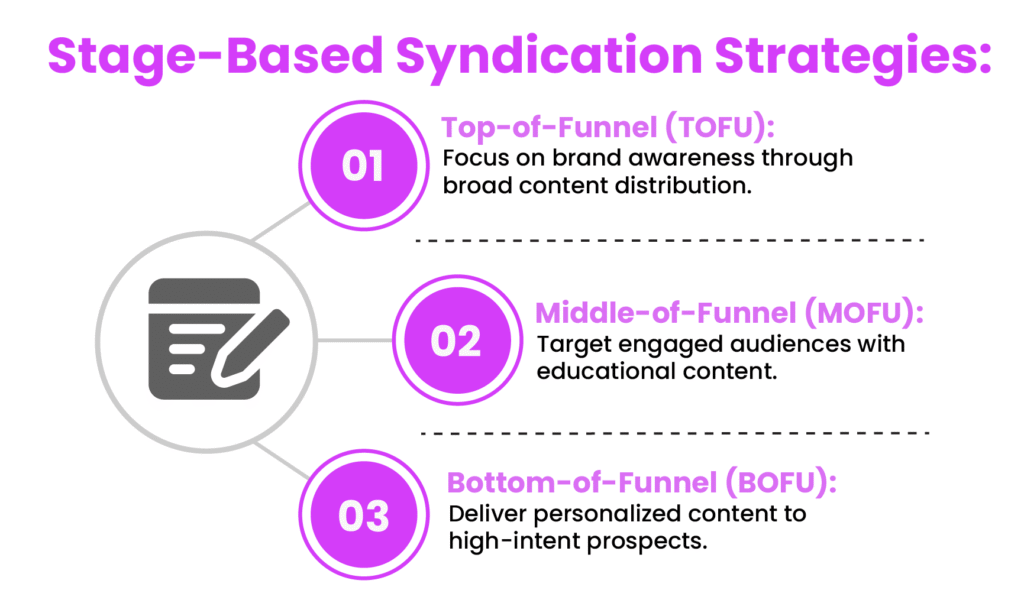Content syndication is a staple for B2B marketers seeking consistent lead flow and brand awareness.
Yet the reality is that most teams are juggling between achieving high lead volumes and ensuring those leads are of high quality.
Everyone wants growth and efficiency, but the path to reaching those goals is complex. As market expectations evolve, getting content syndication right is crucial for ROI and long-term pipeline health.

1. What Are Content Distribution Goals?
For B2B marketers, content distribution goals are the concrete outcomes you expect from syndicating your content across various platforms. These often include:
- Lead volume: Generating a large number of contacts for your funnel.
- Lead quality: Attracting prospects with genuine intent and the right fit.
- Audience engagement: Ensuring distributed content is consumed and acted upon.
- ROI and cost efficiency: Keeping cost per lead reasonable while achieving business impact.
Often it is tempting to aim for all these goals, but you cannot measure each metric on the same scale.
For example, casting a wide net gets you that volume, but precision targeting sharpens quality. Finding the right balance is where most teams struggle.
2. Why Balancing Content Distribution Goals is Challenging
Balancing multiple goals isn’t just a theoretical problem. It’s a real problem that creates real pain points for marketers every day.
Sometimes, in an attempt to excel at one goal, teams compromise on another. Chasing high lead numbers might feel encouraging but can lead to bloated pipelines full of low-value contacts, wasting sales’ time and eroding trust between teams.
On the other hand, focusing too tightly on quality risks missing out on potential buyers who don’t fit a rigid profile but could become strong customers.
What makes matters more complicated is sticking to traditional distribution models that don’t fit today’s buying journeys.
Many B2B organizations still rely on basic demographic filters or last-touch attribution, missing critical signals and undervaluing early-stage content interactions. Teams quickly realize that:
- Manual targeting is inefficient and misses nuance.
- Siloed data across platforms makes it hard to track what’s working.
- Evolving privacy laws restrict old-school tracking tactics.
Top-performing teams are addressing this by pivoting to structured, data-driven frameworks and leveraging technology to make smarter decisions at scale.
Strategic Goal Balancing: How Marketers Are Doing It
A better approach is to match your campaigns to the different stages of the buyer journey. Teams start broad when building awareness, then get more focused as buyers show more interest. Teams that do this well meet regularly to review results and work with sales, making sure they are on the same page.
They keep an eye on both the number of leads and the percentage that turn into real sales opportunities. This disciplined process helps keep everything in balance without guesswork.
For example, if campaign results show too many low-quality leads, teams shift resources to focus on better-fit accounts. If there are not enough leads, they open up to broader audiences, always watching results closely.
Using Technology to Target Smarter
Manual targeting has limits. That is why more teams use AI and intent data to see which companies are really interested. These tools update target lists as new data comes in and help marketers focus on the best accounts.
Some clear benefits are:
- AI-powered targeting cuts waste by focusing on accounts that are actively researching your product area
- Integration with CRM and marketing tools helps teams act fast on new information and see what is working across every channel
With better technology, teams can shift budgets quickly, remove underperforming channels, and focus on strategies that bring real results.
Measuring What Works
One of the biggest frustrations in content syndication is not knowing which tactics are actually paying off. If you only look at leads or clicks, you are missing the bigger picture. The best teams use multi-touch attribution, tracking all the steps a lead takes before becoming a customer.
This approach helps you see which touchpoints matter most and where your marketing investment delivers the best results. A unified dashboard makes it easier to spot patterns, share data with sales, and adjust campaigns quickly.
Benchmarks and Next Steps
If you want to know if your numbers are healthy, the typical cost per lead in B2B tech is between $60 and $80, with conversion rates of 10 to 15 percent. Teams that perform well are always testing new messages, personalizing content for each stage, and nurturing leads instead of giving up after the first touch.
Here is a quick checklist to improve your results:
- Map your content to the different stages of the buyer journey
- Use AI and intent data for better targeting
- Set up multi-touch attribution for a clear view of performance
- Compare your results with industry benchmarks and keep testing and improving
If you want help reviewing your content syndication process, reach out to our team for practical advice and a free assessment.
Frequently Asked Questions (FAQs)
Why do lead quality and quantity seem to work against each other in content syndication?
When you focus on one, you often lose ground on the other. Set clear targets, get sales and marketing to work together, and adjust as you see the results.
What tools should I use to improve my targeting?
AI-powered audience tools and intent data platforms help you find and reach the best prospects at the right time.
How do I know if my content syndication is successful?
Use multi-touch attribution and dashboards that show you results from all your channels, not just one part of the process.
What is the first thing I should do to get better outcomes?
Start by mapping your content and channels to each buyer stage, then use smarter targeting and better measurement.




